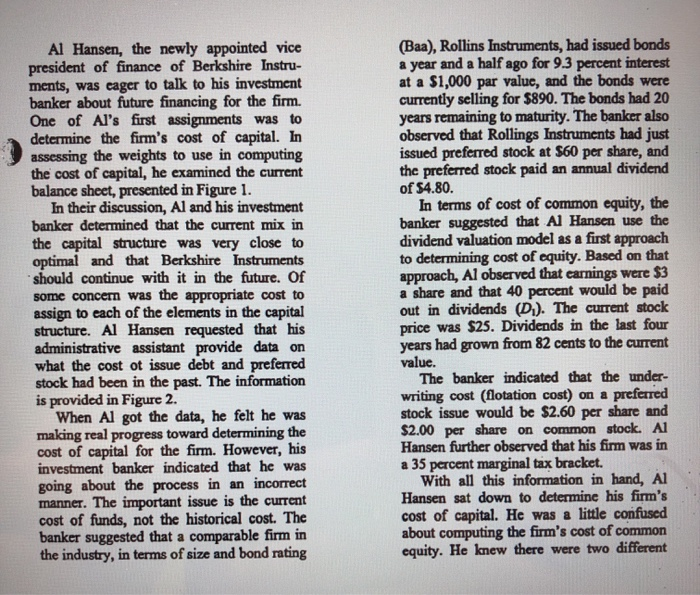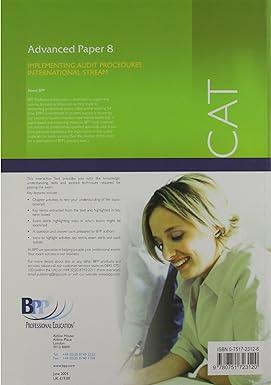1. Determine the weighted average cost of capital based on using retained earnings in the capital structure. The percentage composition in the capital structure for bonds, preferred stock, and common equity should be based on the current capital structure of long-term financing as shown in Figure 1 (it adds up to $18 million). Common equity will represent 60 percent of financing throughout this case. $ 400,000 200,000 $ 2,600,000 300.000 2,300,000 5.500.000 $ 8,400,000 30,700,000 13.200.000 Assets Current assets: Cash.. Marketable securities. Accounts receivable.. Less: Allowance for bad debts Inventory............. Total current assets Fixed Assets: Plant and equipment, original cost. Less: Accumulated depreciation. Net plant and equipment. Total assets Liabilities and Stockholders' Equity Current liabilities: Accounts payable. Accrued expenses Total current liabilities.. Long-term financing Bonds payable... Preferred stock.. Common stock 17.500.000 $25.900.000 S 6,200,000 1.700.000 7,900,000 Retained earnings } Common equity + $ 6,120,000 + 1,080,000 6,300,000 4.500.000 10,800,000 - 18.000.000 $25.900.000 Total common equity...... Total long-term financing. Total liabilities and stockholders' equity. Year of Issue Yield Ted Security Bond Bond Bond. Preferred stock Preferred stock 1992 1996 2002 1997 2000 Amount $1,120,000 3,000,000 2,000,000 600,000 480,000 6.1% 13.8 8.3 12.0 7.9 Al Hansen, the newly appointed vice president of finance of Berkshire Instru- ments, was eager to talk to his investment banker about future financing for the firm. One of Al's first assignments was to determine the firm's cost of capital. In assessing the weights to use in computing the cost of capital, he examined the current balance sheet, presented in Figure 1. In their discussion, Al and his investment banker determined that the current mix in the capital structure was very close to optimal and that Berkshire Instruments should continue with it in the future. Of some concern was the appropriate cost to assign to each of the elements in the capital structure. Al Hansen requested that his administrative assistant provide data on what the cost ot issue debt and preferred stock had been in the past. The information is provided in Figure 2. When Al got the data, he felt he was making real progress toward determining the cost of capital for the firm. However, his investment banker indicated that he was going about the process in an incorrect manner. The important issue is the current cost of funds, not the historical cost. The banker suggested that a comparable firm in the industry, in terms of size and bond rating (Baa), Rollins Instruments, had issued bonds a year and a half ago for 9.3 percent interest at a $1,000 par value, and the bonds were currently selling for $890. The bonds had 20 years remaining to maturity. The banker also observed that Rollings Instruments had just issued preferred stock at $60 per share, and the preferred stock paid an annual dividend of $4.80. In terms of cost of common equity, the banker suggested that Al Hansen use the dividend valuation model as a first approach to determining cost of equity. Based on that approach, Al observed that earnings were $3 a share and that 40 percent would be paid out in dividends (D.). The current stock price was $25. Dividends in the last four years had grown from 82 cents to the current value. The banker indicated that the under- writing cost (flotation cost) on a preferred stock issue would be $2.60 per share and $2.00 per share on common stock. Al Hansen further observed that his firm was in a 35 percent marginal tax bracket. With all this information in hand, Al Hansen sat down to determine his firm's cost of capital. He was a little confused about computing the firm's cost of common equity. He knew there were two different 1. Determine the weighted average cost of capital based on using retained earnings in the capital structure. The percentage composition in the capital structure for bonds, preferred stock, and common equity should be based on the current capital structure of long-term financing as shown in Figure 1 (it adds up to $18 million). Common equity will represent 60 percent of financing throughout this case. $ 400,000 200,000 $ 2,600,000 300.000 2,300,000 5.500.000 $ 8,400,000 30,700,000 13.200.000 Assets Current assets: Cash.. Marketable securities. Accounts receivable.. Less: Allowance for bad debts Inventory............. Total current assets Fixed Assets: Plant and equipment, original cost. Less: Accumulated depreciation. Net plant and equipment. Total assets Liabilities and Stockholders' Equity Current liabilities: Accounts payable. Accrued expenses Total current liabilities.. Long-term financing Bonds payable... Preferred stock.. Common stock 17.500.000 $25.900.000 S 6,200,000 1.700.000 7,900,000 Retained earnings } Common equity + $ 6,120,000 + 1,080,000 6,300,000 4.500.000 10,800,000 - 18.000.000 $25.900.000 Total common equity...... Total long-term financing. Total liabilities and stockholders' equity. Year of Issue Yield Ted Security Bond Bond Bond. Preferred stock Preferred stock 1992 1996 2002 1997 2000 Amount $1,120,000 3,000,000 2,000,000 600,000 480,000 6.1% 13.8 8.3 12.0 7.9 Al Hansen, the newly appointed vice president of finance of Berkshire Instru- ments, was eager to talk to his investment banker about future financing for the firm. One of Al's first assignments was to determine the firm's cost of capital. In assessing the weights to use in computing the cost of capital, he examined the current balance sheet, presented in Figure 1. In their discussion, Al and his investment banker determined that the current mix in the capital structure was very close to optimal and that Berkshire Instruments should continue with it in the future. Of some concern was the appropriate cost to assign to each of the elements in the capital structure. Al Hansen requested that his administrative assistant provide data on what the cost ot issue debt and preferred stock had been in the past. The information is provided in Figure 2. When Al got the data, he felt he was making real progress toward determining the cost of capital for the firm. However, his investment banker indicated that he was going about the process in an incorrect manner. The important issue is the current cost of funds, not the historical cost. The banker suggested that a comparable firm in the industry, in terms of size and bond rating (Baa), Rollins Instruments, had issued bonds a year and a half ago for 9.3 percent interest at a $1,000 par value, and the bonds were currently selling for $890. The bonds had 20 years remaining to maturity. The banker also observed that Rollings Instruments had just issued preferred stock at $60 per share, and the preferred stock paid an annual dividend of $4.80. In terms of cost of common equity, the banker suggested that Al Hansen use the dividend valuation model as a first approach to determining cost of equity. Based on that approach, Al observed that earnings were $3 a share and that 40 percent would be paid out in dividends (D.). The current stock price was $25. Dividends in the last four years had grown from 82 cents to the current value. The banker indicated that the under- writing cost (flotation cost) on a preferred stock issue would be $2.60 per share and $2.00 per share on common stock. Al Hansen further observed that his firm was in a 35 percent marginal tax bracket. With all this information in hand, Al Hansen sat down to determine his firm's cost of capital. He was a little confused about computing the firm's cost of common equity. He knew there were two different









